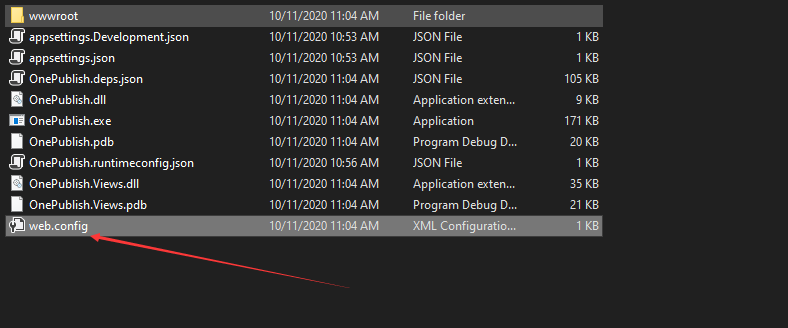1.项目创建
使用Visual Studio 2019 创建一个Asp.NetCore WebApplication 并选择MVC项目命名为OnePublish。

确认运行无误后我们来探讨一下Asp.NetCore项目的运行启动方式以及他与Asp.Net的区别。
2.项目运行
IIS Express运行效果:
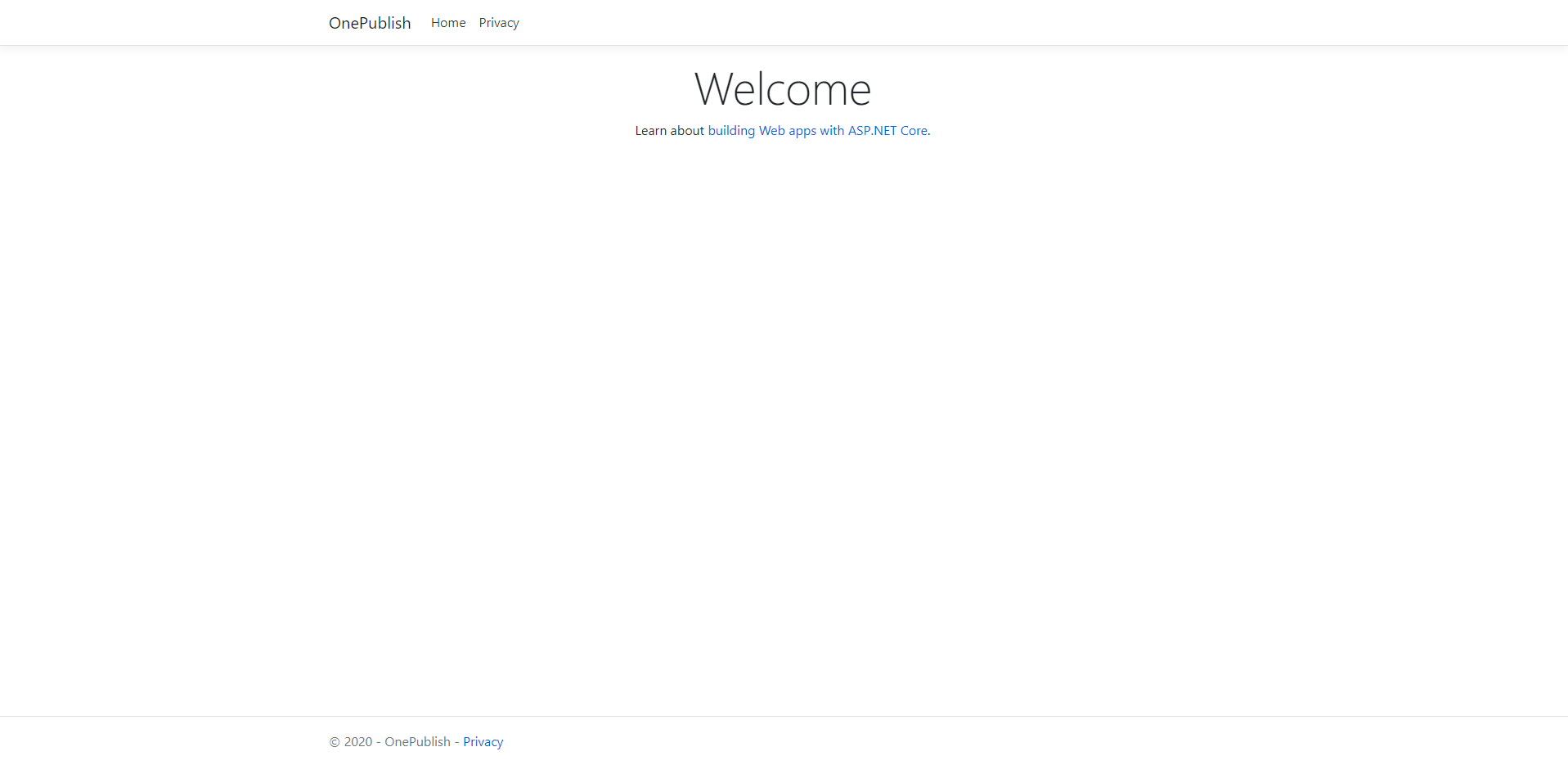
结果不出乎意料和Asp.Net相似都能成功的运行Web项目,但在Asp.NetCore中新增了一种使用CommandLine运行的方式,我们可以从配置文件或者VS设置中可以看出。
项目属性设置:

LaunchSettings.json
1 { 2 "iisSettings": { 3 "windowsAuthentication": false, 4 "anonymousAuthentication": true, 5 "iisExpress": { 6 "applicationUrl": "http://localhost:54012", 7 "sslPort": 0 8 } 9 }, 10 "profiles": { 11 "IIS Express": { 12 "commandName": "IISExpress", 13 "launchBrowser": true, 14 "environmentVariables": { 15 "ASPNETCORE_ENVIRONMENT": "Development" 16 } 17 }, 18 "OnePublish": { 19 "commandName": "Project", 20 "launchBrowser": true, 21 "applicationUrl": "http://localhost:5000", 22 "environmentVariables": { 23 "ASPNETCORE_ENVIRONMENT": "Development" 24 } 25 } 26 } 27 }
我们可以看见以"OnePublish"为名的CommandLine也可以成功运行Web项目,那Asp.NetCore是如何做到从命令行实现Web项目的呢?
原因在于ASP.NET Core不再是由IIS工作进程(w3wp.exe)托管,而是使用自托管Web服务器(Kestrel)运行,IIS则是作为反向代理的角色转发请求到Kestrel不同端口的ASP.NET Core程序中,随后就将接收到的请求推送至中间件管道中去,处理完你的请求和相关业务逻辑之后再将HTTP响应数据重新回写到IIS中,最终转达到不同的客户端(浏览器,APP,客户端等)。
官方文档图解:
Kestrel used as an edge (Internet-facing) web server:

Kestrel used in a reverse proxy configuration:

我的理解为:当Kestrel作为Eage Server监听某一个ip或者端口时,它可以接受所有由该端口发送的信息并解决他们的请求。但当有反向代理的存在时如(IIS,Nginx,Apache),反向代理可以接受多个Kestrel托管的端口来接受他们的信息并完成他们的请求。总结来说在Asp.NetCore中Kestrel已经组成一个完整的生态,而代理服务器大多起一个监听的作用了。那Kestrel在哪里启动的呢?
首先我们来观察一下这两个类文件。

Program.cs:
1 using Microsoft.AspNetCore.Hosting; 2 using Microsoft.Extensions.Hosting; 3 4 namespace OnePublish 5 { 6 public class Program 7 { 8 public static void Main(string[] args) 9 { 10 CreateHostBuilder(args).Build().Run(); 11 } 12 13 public static IHostBuilder CreateHostBuilder(string[] args) => 14 Host.CreateDefaultBuilder(args) 15 .ConfigureWebHostDefaults(webBuilder => 16 { 17 webBuilder.UseStartup<Startup>(); 18 }); 19 } 20 }
我们知道Main函数一般为程序的入口。在此函数中我们可以看见是调用了一系列方法,这可能还不够简单明了,我们对此方法做一点简化。
1 public static void Main(string[] args) 2 { 3 var hostBuilder = CreateHostBuilder(args); 4 var host = hostBuilder.Build(); 5 host.Run(); 6 }
现在我们可以理解为它使用CreateHsotBuilder()方法创建了一个hostBuilder,在利用hostBuilder创建了一个host主机实体对象,在Run这个Host主机。
那么这个HostBuiler到底做了什么配置又创建了一些什么东西呢?
我们对源码进行解读一下:
1 public static IHostBuilder CreateDefaultBuilder(string[] args) 2 { 3 HostBuilder hostBuilder = new HostBuilder(); 4 hostBuilder.UseContentRoot(Directory.GetCurrentDirectory()); 5 hostBuilder.ConfigureHostConfiguration((Action<IConfigurationBuilder>) (config => 6 { 7 config.AddEnvironmentVariables("DOTNET_"); 8 if (args == null) 9 return; 10 config.AddCommandLine(args); 11 })); 12 hostBuilder.ConfigureAppConfiguration((Action<HostBuilderContext, IConfigurationBuilder>) ((hostingContext, config) => 13 { 14 IHostEnvironment hostingEnvironment = hostingContext.HostingEnvironment; 15 config.AddJsonFile("appsettings.json", true, true).AddJsonFile("appsettings." + hostingEnvironment.EnvironmentName + ".json", true, true); 16 if (hostingEnvironment.IsDevelopment() && !string.IsNullOrEmpty(hostingEnvironment.ApplicationName)) 17 { 18 Assembly assembly = Assembly.Load(new AssemblyName(hostingEnvironment.ApplicationName)); 19 if (assembly != (Assembly) null) 20 config.AddUserSecrets(assembly, true); 21 } 22 config.AddEnvironmentVariables(); 23 if (args == null) 24 return; 25 config.AddCommandLine(args); 26 })).ConfigureLogging((Action<HostBuilderContext, ILoggingBuilder>) ((hostingContext, logging) => 27 { 28 int num = RuntimeInformation.IsOSPlatform(OSPlatform.Windows) ? 1 : 0; 29 if (num != 0) 30 logging.AddFilter<EventLogLoggerProvider>((Func<LogLevel, bool>) (level => level >= LogLevel.Warning)); 31 logging.AddConfiguration((IConfiguration) hostingContext.Configuration.GetSection("Logging")); 32 logging.AddConsole(); 33 logging.AddDebug(); 34 logging.AddEventSourceLogger(); 35 if (num == 0) 36 return; 37 logging.AddEventLog(); 38 })).UseDefaultServiceProvider((Action<HostBuilderContext, ServiceProviderOptions>) ((context, options) => 39 { 40 bool flag = context.HostingEnvironment.IsDevelopment(); 41 options.ValidateScopes = flag; 42 options.ValidateOnBuild = flag; 43 })); 44 return (IHostBuilder) hostBuilder; 45 }
可以看到它对路径做了一个默认的规定,并的确的使用的CommandLine并可接受参数,这也是为什么我们可以通过CommandLine控制Web程序的原因,还有对appsettings.json文件的引用,从这里我们可以看出我们也是可以自定义配置文件的。还添加了Logging这些基本功能。
继续向源码解读可以看到在ConfigureWebDefaults方法中,Asp.NetCore确实使用了Kestrel并对他的一些option进行了默认的规定。到这里我们就基本了明白了Asp.NetCore WebApplication的启动流程了。
internal static void ConfigureWebDefaults(IWebHostBuilder builder) { builder.ConfigureAppConfiguration((Action<WebHostBuilderContext, IConfigurationBuilder>) ((ctx, cb) => { if (!ctx.HostingEnvironment.IsDevelopment()) return; StaticWebAssetsLoader.UseStaticWebAssets(ctx.HostingEnvironment, ctx.Configuration); })); builder.UseKestrel((Action<WebHostBuilderContext, KestrelServerOptions>) ((builderContext, options) => options.Configure((IConfiguration) builderContext.Configuration.GetSection("Kestrel")))).ConfigureServices((Action<WebHostBuilderContext, IServiceCollection>) ((hostingContext, services) => { services.PostConfigure<HostFilteringOptions>((Action<HostFilteringOptions>) (options => { if (options.AllowedHosts != null && options.AllowedHosts.Count != 0) return; string str = hostingContext.Configuration["AllowedHosts"]; string[] strArray1; if (str == null) strArray1 = (string[]) null; else strArray1 = str.Split(new char[1]{ ';' }, StringSplitOptions.RemoveEmptyEntries); string[] strArray2 = strArray1; HostFilteringOptions filteringOptions = options; string[] strArray3; if (strArray2 == null || strArray2.Length == 0) strArray3 = new string[1]{ "*" }; else strArray3 = strArray2; filteringOptions.AllowedHosts = (IList<string>) strArray3; })); services.AddSingleton<IOptionsChangeTokenSource<HostFilteringOptions>>((IOptionsChangeTokenSource<HostFilteringOptions>) new ConfigurationChangeTokenSource<HostFilteringOptions>(hostingContext.Configuration)); services.AddTransient<IStartupFilter, HostFilteringStartupFilter>(); if (string.Equals("true", hostingContext.Configuration["ForwardedHeaders_Enabled"], StringComparison.OrdinalIgnoreCase)) { services.Configure<ForwardedHeadersOptions>((Action<ForwardedHeadersOptions>) (options => { options.ForwardedHeaders = ForwardedHeaders.XForwardedFor | ForwardedHeaders.XForwardedProto; options.KnownNetworks.Clear(); options.KnownProxies.Clear(); })); services.AddTransient<IStartupFilter, ForwardedHeadersStartupFilter>(); } services.AddRouting(); })).UseIIS().UseIISIntegration(); }
3.区别:
在我看来Asp.Net就像一个全家桶,在我默认使用框架中基本上包含了所有进行Web开发的框架如HttpContext,Session等。而Asp.NetCore更像是一个自选桶你可以在StartUp.cs中自定义的添加你需要的Services。在我看来,Asp.NetCore变得更加透明和更加灵活了。
4.部署和发布。
1. 我们将此项目用文件系统打包部署到本地即可。点击Publish即可。
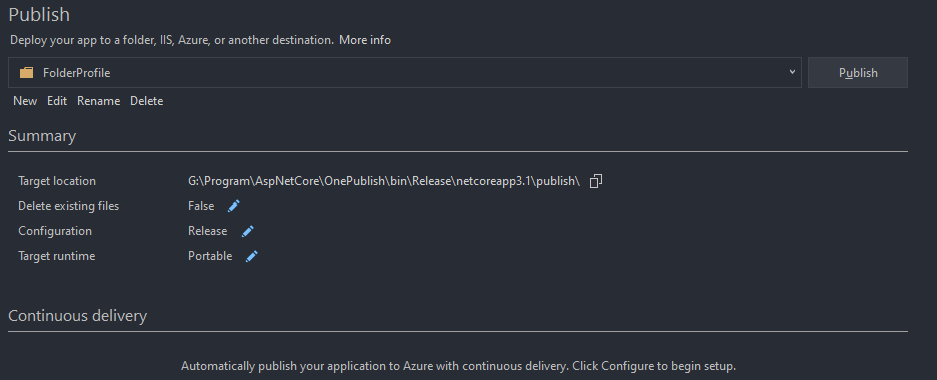

2. 确保打开Windows的IIS服务。

确保IIS中安装了AspNetCoreModule.
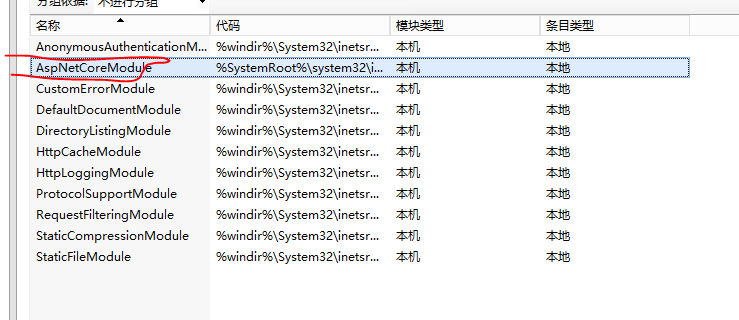
若无安装(去安装):下载安装即可
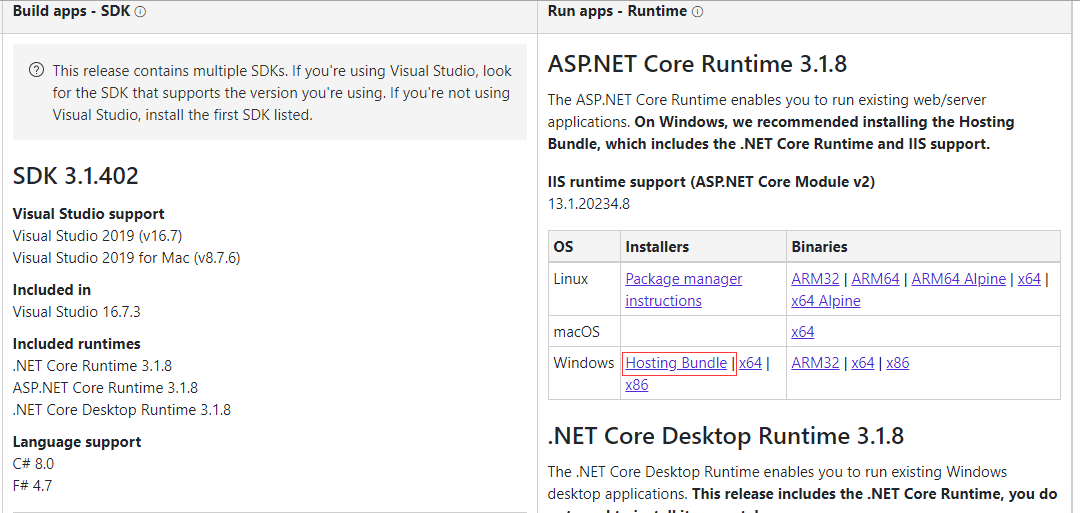
现在来添加IIS服务
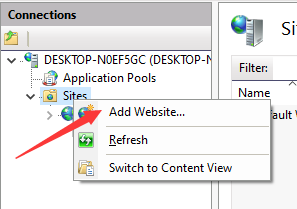
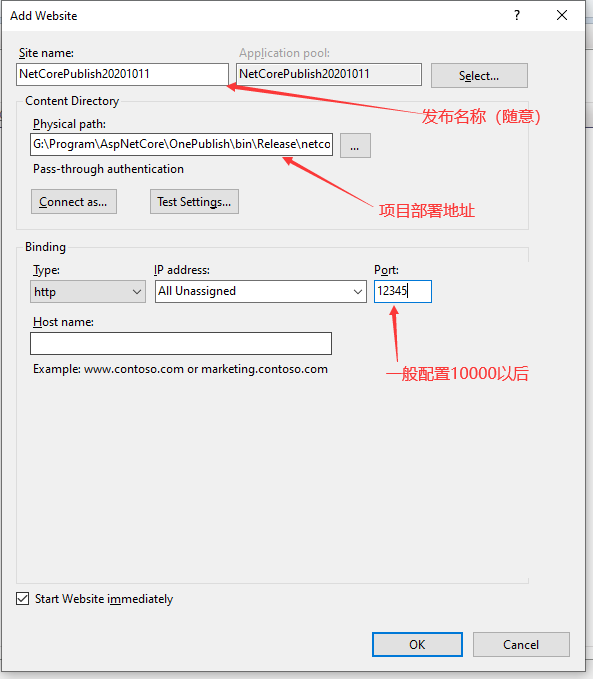

运行成功,即发布成功了。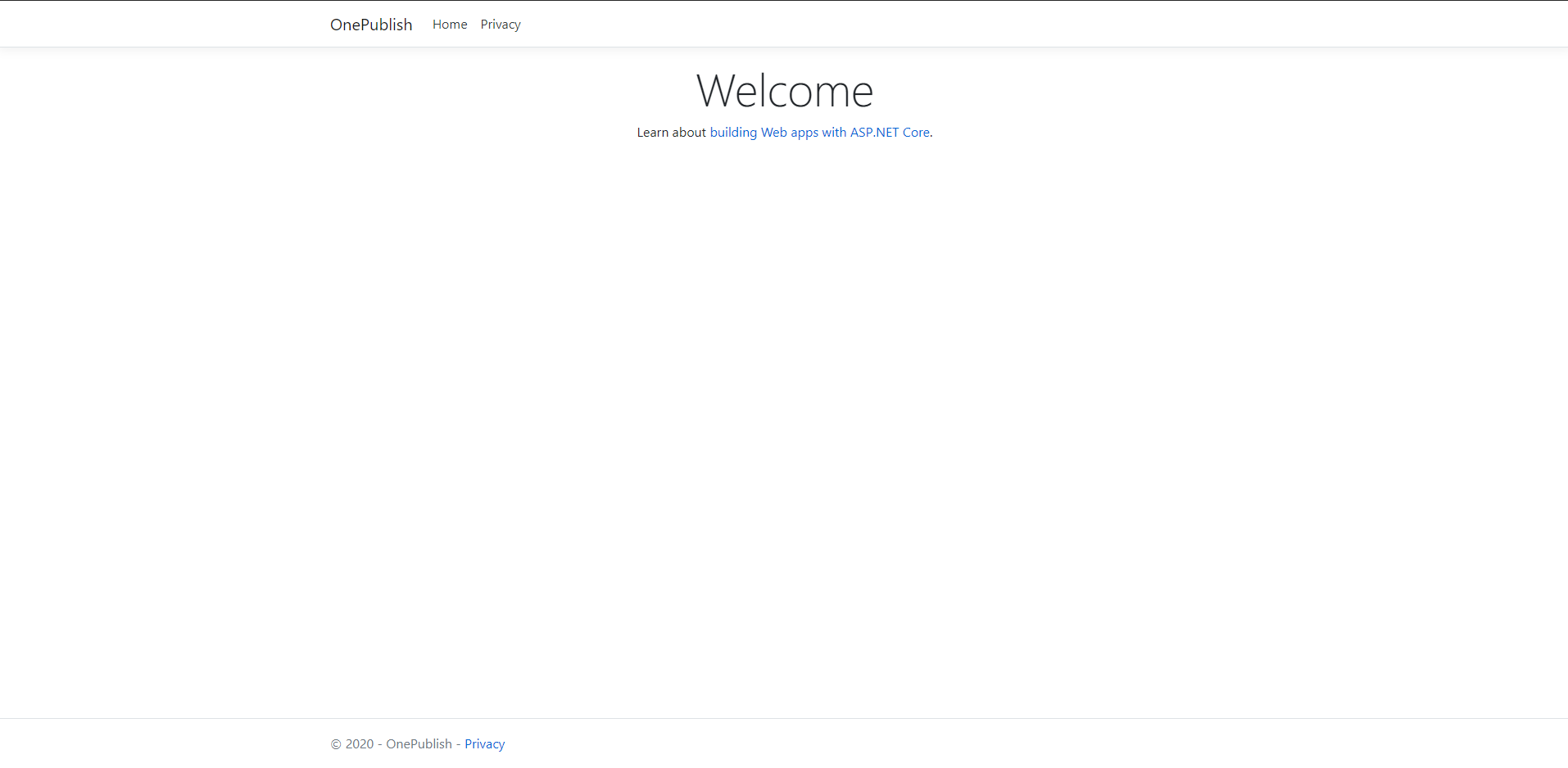
若不能成功运行请检查部署目录中是否有此文件。
